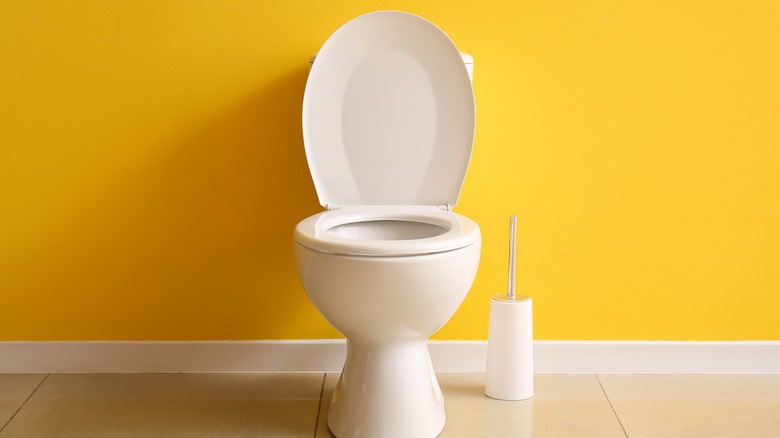Should You Be Worried About Yellow Poop? Here's What We Know
Our poop can come in a wide range of colors and hues. The same is true for yellow stool, which can appear anywhere between light yellow and a shade of mustard yellow. We apologize for the visual — but it's important to know whether yellow poop is something to worry about in the event that you notice any unusual color changes the next time you're going number two.
Yellow poop can stem from a number of different health conditions, but if a yellow-tinted bowel movement comes on after you've upped your intake of sweet potatoes, carrots, or enjoyed a sugary treat made with Yellow 5 food dye, then there's likely nothing to worry about. Similarly, excess consumption of gluten or fatty foods can also contribute to yellow poops. Diet isn't the only lifestyle factor that can influence the color of our waste, however — our stress levels can too. When we're strained or anxious, digestion gets kicked into high gear. As our gastrointestinal tract picks up the pace, our body may not adequately absorb some nutrients, resulting in yellow poop.
Disorders and infections related to yellow stool
Bile is a yellow-tinted fluid that plays a role in the color of our poop. Its salt content helps metabolize fat from food sources and expel it from the body as waste. Certain liver and gallbladder disorders, however, can decrease levels of bile salts in the body, which can cause our poop to appear yellow or pale. Such disorders include cirrhosis, hepatitis, or gallstones.
People with certain pancreas disorders may also notice their stool appears yellow in color. Disorders such as cystic fibrosis, pancreatic cancer, chronic pancreatitis, or pancreatic duct blockages interfere with the organ's ability to produce digestive enzymes for the intestines to break down fat. As a result, one's poop may look frothy, greasy, or yellow.
A parasitic infection known as giardiasis can also cause yellow poop. In a 2021 study published in BMJ Case Reports, a patient in their late 20s with iron deficiency anemia reported passing oily, floating stool that was a shade of yellow-brown as many as four times a day. Similar to pancreatic disorders, chronic giardiasis was found to be the reason why the woman's pancreas was unable to produce necessary digestive enzymes.
Other causes of yellow poop in adults and babies
Celiac disease — in which gluten consumption prompts the body to self-attack the small intestine — is another potential cause of yellow poop. Additional symptoms may also include diarrhea, constipation, bloating, bone density loss, or more. People with Crohn's disease may alternatively notice a yellow-colored film covering their poop, which can also appear as streaks. In the event that a patient develops malabsorption issues related to the condition, stool may then look fully yellow as opposed to just having a yellow covering. If you're worried the color may be related to a health condition, reach out to your doctor.
In young babies, yellow poop is not usually something to worry about. Mayo Clinic experts explain that breastfed infants often produce loose, mustard-tinted poops that may be accompanied by shades of green. In fact, results of an early 2009 study published in Archives of Disease in Childhood that involved nearly 13,000 children showed that yellow was the most commonly reported stool color by parents of 4-week-old babies. At 6-months-old, brown was the most frequently reported stool color. While yellow baby poop may not be cause for concern, here are some warning signs to keep an eye out for in their stool.



